Syracuse’s rich Ancient Greek to Baroque heritage reaches an apex on Ortygia Island, where the additional seaside appeal and cultural riches make it an ideal compendium of Sicilian history and lifestyle.
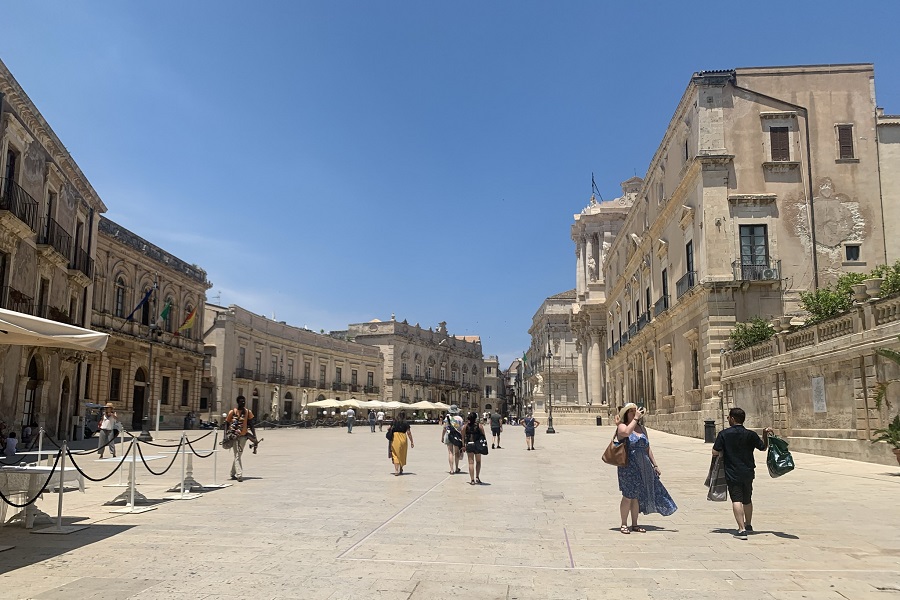
Piazza Duomo (Photo: Andrea Gambaro)
Enclosed within a one-square-km island, Ortygia has a boutique feel to it. Visitors wander past awe-inspiring Baroque façades and ornate balconies hanging from low houses, while leafy alleyways might open up at any turn onto dreamy seascapes. Both the grand monuments and small details exude Sicilian splendour, enhanced by the hard sun splashing off fair stone. The main square is one of the finest in Italy, whose mood changes gracefully according to light over the course of the day.
The perspective shifts when you think of this small island as the core of the largest metropolis of Ancient Greece: Syracuse. Founded by Corinthian settlers, the city had its heyday in the fifth and fourth centuries BCE, when it emerged as one of the greatest powers in the Mediterranean region. Such a past has left behind impressive heritage both in Ortygia and on the mainland, besides which later civilisations added new layers of art and architecture. The wealth of Greek, Roman, Byzantine, Arab and Norman landmarks makes this a unique cradle of Mediterranean culture, and was rightly listed as a UNESCO site since 2005.
Things to do
Two adjacent bridges cover the narrow gap between the mainland and Ortygia. The Temple of Apollo stands near them, as if to welcome visitors to the island. Dating back to the 6th century BCE, the Apollónion is the earliest-known Doric temple in Magna Graecia (as the Romans dubbed the Italian settlements of Ancient Greece). Monolithic columns and a singular architecture reveal it as a pioneering feat, and so does the unusual celebratory inscription left by the architect. Details such as the Arabic engraving and the Byzantine front stairs hint at the architectural stratification over the centuries, which will be found elsewhere in Ortygia in more striking examples.
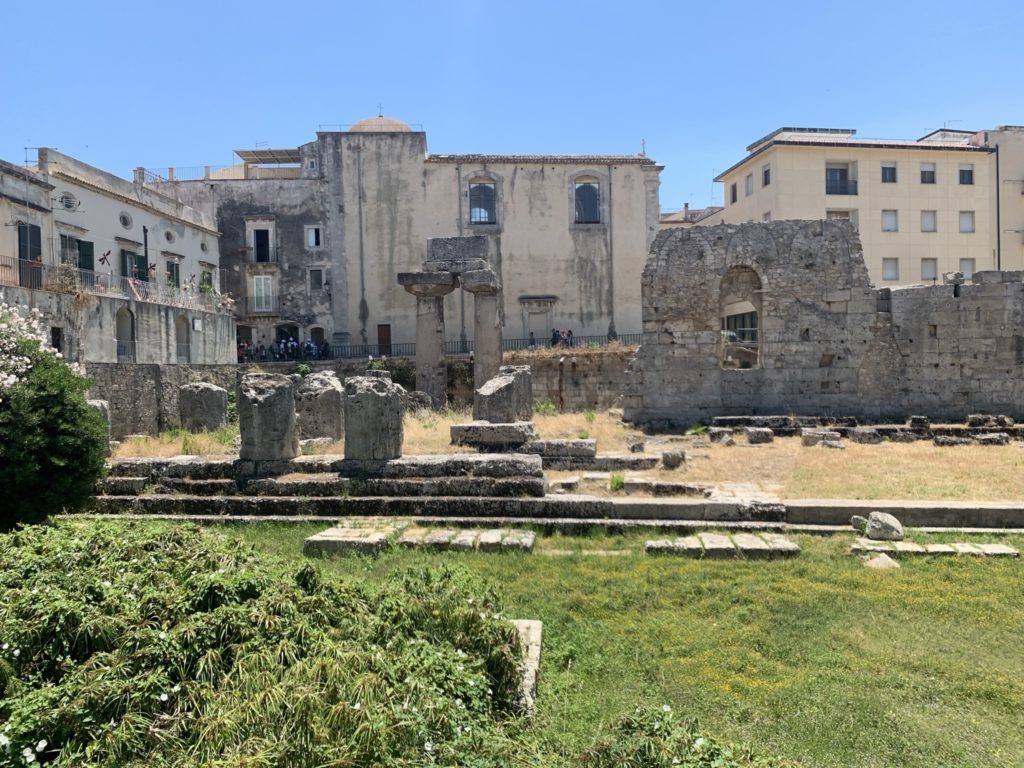
The Apollónion seen from one of its sides (Photo: Andrea Gambaro)
As a counterpoint to the silent stones of the temple, the local market buzzes from a side street. The vendors’ street cries lend a note of Sicilian folklore to the family-run stalls brimming with fresh produce, dried fruit, legumes, cheese, meat and other goods. Rich displays of fish and seafood take centre stage – a vivid reminiscence of the old fish market that used to be held in the adjoining building (now closed). Local delis stand alongside the traditional stalls, offering a range of options for a quick lunch break.
The winding alleyways of Ortygia are dotted with countless churches, ancient palaces, quaint corners and charming courtyards. Aimless wandering provides one surprising sight after the other, eventually leading to Piazza Duomo. This elongated square slopes slightly southwards, where noble palaces look up at the Baroque façade of the cathedral. The site where the cathedral stands today has been home to a place of worship since Ortygia’s earliest history. Parts of the original Temple of Athena are visible both outside and inside the church, weaving an enchanting dialogue with the art and architecture of later eras. The visit to the Duomo includes the neighbouring Palazzo Arcivescovile, while the Church of Santa Lucia is home to a Caravaggio painting.
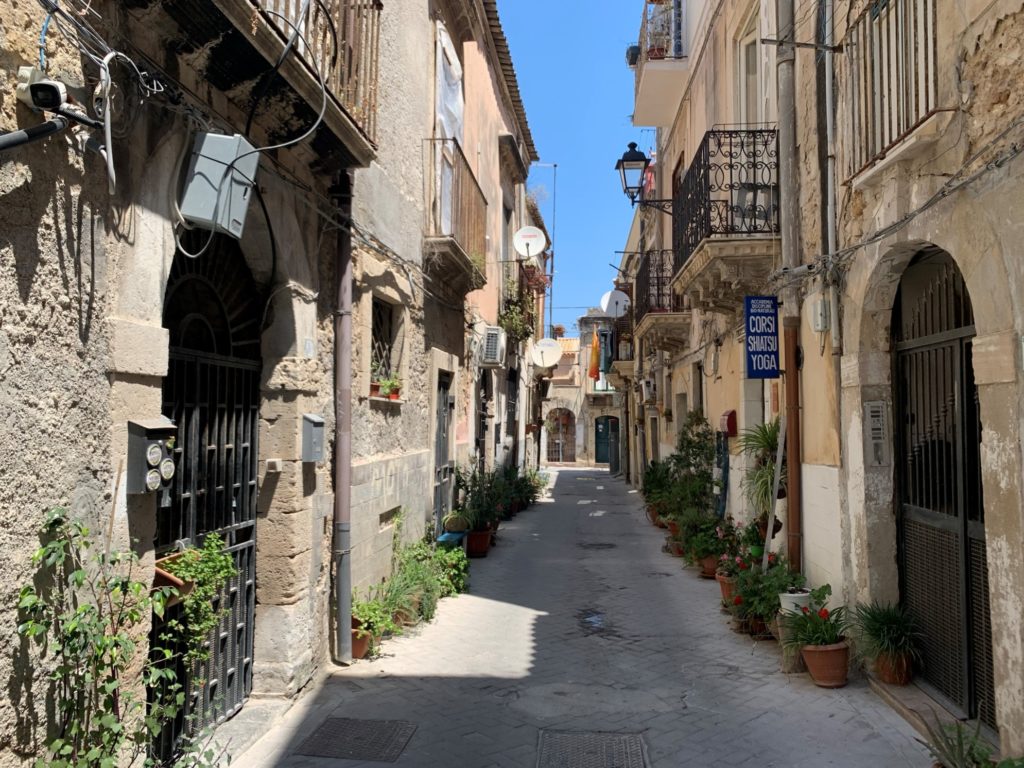
The alleyways of Ortygia offer plenty of opportunities for detours (Photo: Andrea Gambaro)
Around the corner from the square is the Arethusa Spring, a natural pool of fresh water flowing into the Great Harbour. It’s the only place in Europe where papyrus grows spontaneously, and its charming aura draws on myth and history in equal measure. Take a guided tour to learn about the ancient myth of Alpheus and Arethusa, or about the Oracle of Delphi who mentioned the spring to the Greek settlers enquiring about their upcoming expedition.
The next landmark to seek out is Castello Maniace, a former fortress and prison jutting out into the Ionian Sea from the southern tip of Ortygia. Erected in the 13th century under Frederick II’s rule, it was later named after the Byzantine general who had conquered the city from the Arabs in 1038. Its chronicles include a violent explosion caused by lighting in 1704, as well as an infamous ‘red’ banquet which will certainly ring a bell with Game of Thrones fans. The castle hosts temporary exhibitions ranging from sculpture to contemporary art.
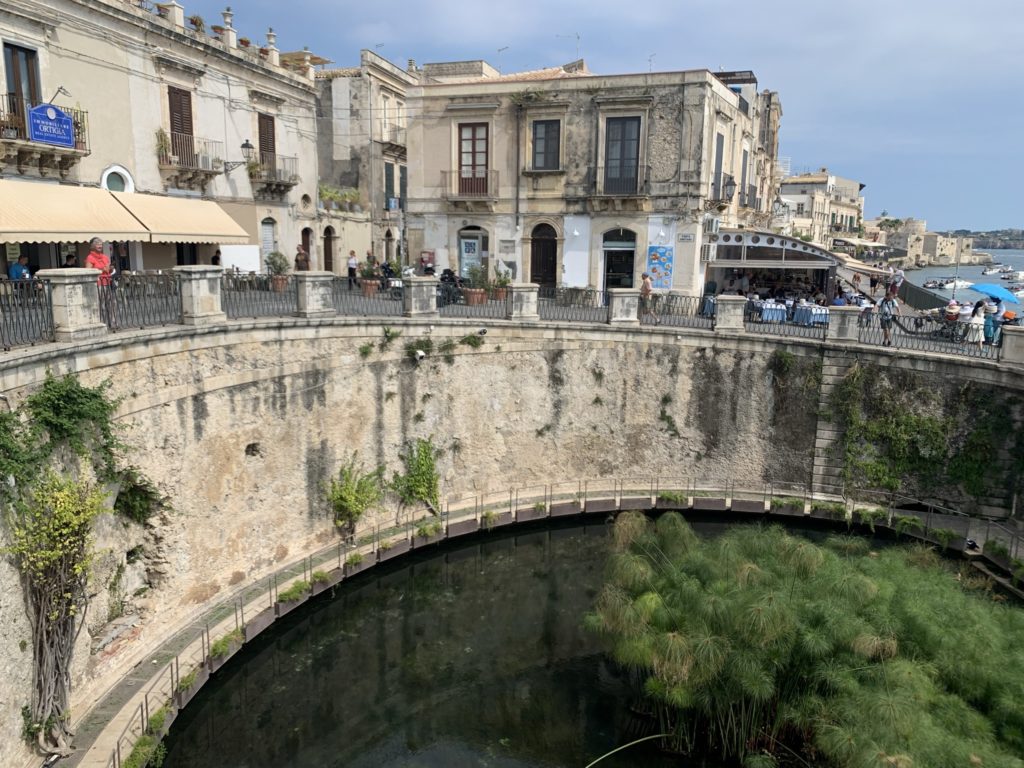
Papyrus growing in the Arethusa Spring (Photo: Andrea Gambaro)
Head to the east coast when it’s time for seaside leisure. Cala Rossa and Forte Vigliena are the best spots, where swimming and sunbathing are backdropped by cliff-side architecture. This part of the island also includes the picturesque Giudecca, formerly the Jewish quarter. The plant-lined Vicolo delle Pergole might well be the most photographed in town, while the roofless church of San Giovanni is a popular location for events and weddings. Check out the marionette theatre and museum to discover a centuries-old Sicilian tradition reviving chivalric poems from the Renaissance at the Museo dei Pupi.
Venturing to the mainland, the Neapolis Archaeological Park is one of the largest sites of its kind in the Mediterranean region. The spectacular Greek amphitheatre hosts a programme of Classic comedies and tragedies during the summer, while the rest of the year might be best to see it in full (the original bleachers are covered when the theatre season is on). Roman heritage, monumental grottos and ancient necropolises are also part of the tour, as well as the ‘Tomb of Archimedes’. This might not be the actual burial site of the great inventor, but still has been used by Syracusan people to remember their most illustrious ancestor.

The Fountain of Diana depicts the myth of Alpheus and Arethusa (Photo: Andrea Gambaro)
Other attractions in mainland Syracuse are the Church of San Giovanni alle Catacombe and the Church of Santa Lucia al Sepolcro, both including ancient catacombs. Back in Ortygia, Galleria Regionale di Palazzo Bellomo displays Sicilian art from the Byzantines to the 18th century, while the Papyrus Museum and the Archimede & Leonardo Museum are also worth a visit.
Where to stay
A small and intimate boutique hotel, Hotel Gutkowski (Lungomare di Levante Elio Vittorini, 18) offers charm and value on the east coast of Ortygia. Its excellent seafront location is best enjoyed from the panoramic rooftops, if not from the private balconies provided by some of the rooms. These two 19th-century buildings used to house artisans and fishermen, and some of the original furniture blends in seamlessly with minimalistic combinations of wood, tiled floors and light colours. The overall Mediterranean feel is tastefully punctuated with German and Polish touches, in keeping with the story behind the hotel’s name. A rich buffet breakfast and an on-site restaurant complete the experience.
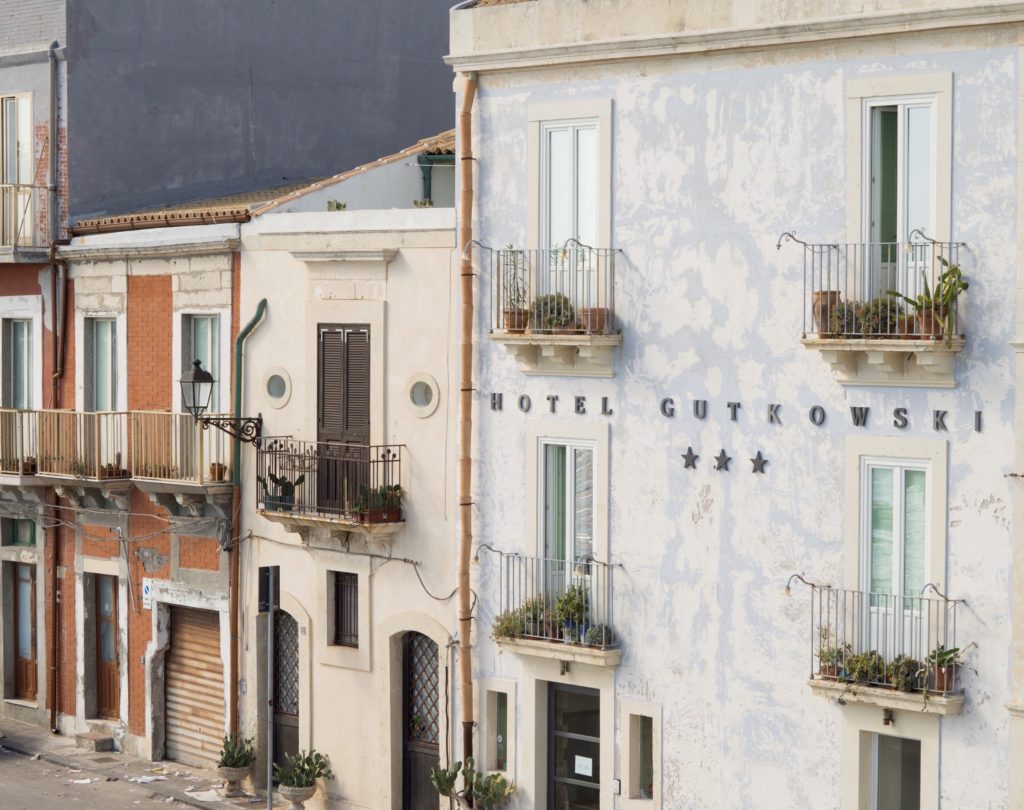
(Photo: courtesy of Hotel Gutkowski)
At Henry’s House (Via Castello Maniace, 68), luxury and comfort come together with blissful vistas of the harbour. It is housed in a 19th-century palace at the southern tip of Ortygia, a stone’s throw from the Arethusa Spring and Castello Maniace. Period furniture, original flooring, frescoes and Sicilian art create an eclectic and elegant atmosphere, where each space conveys a distinctive feel and style. Some of the rooms look out at the sea, while others provide equally charming views of Ortygia’s rooftops. Breakfast on the seafront terrace includes Sicilian delicacies and continental options from local producers.
Algilà(Via Vittorio Veneto, 93) is a four-star hotel conveniently located only steps away from the sea. It features Baroque and medieval elements across two historic palaces, where each space is uniquely designed according to an elegant and sophisticated style. The 54 rooms available include seafront and spa options, the latter boasting a private terrace complete with a jacuzzi. Majolicas and Mediterranean period furniture provide a comforting and harmonious ambience throughout the hotel. The on-site restaurant offers a creative take on the local cuisine.
Eat & Drink
A vegan restaurant, cocktail bar and cultural space, MOON (Via Roma 112) stands for ‘Move Ortygia Out of Normality’. Their recipe for doing so, on the culinary front, is a list of plant-based dishes where reinvented classics meet brand new creations. Gluten-free and raw options are available, with sample dishes including saffron and courgette lasagne sprinkled with Bronte pistachios, MOONzarella with tomato ice cream, and arancini trio. The wide choice of signature cocktails is just as inventive, topped by a curated selection of whisky, rum and other spirits. MOON’s bright and art-filled interiors regularly host exhibitions, performances and music events.
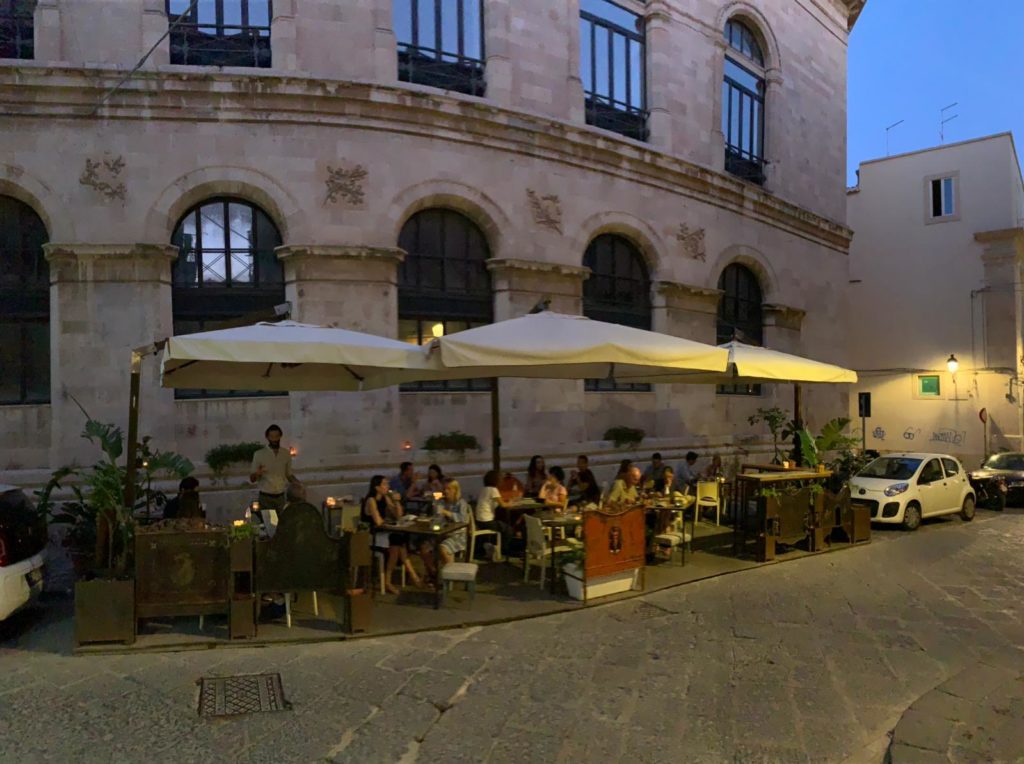
Outdoor seating is also available at MOON (Photo: courtesy of MOON)
A must-try for cheese lovers, Caseificio Borderi is one of the most popular spots at Ortygia’s market. This family-run company started making cheese in 1970, and soon established itself as a local reference in the field. While stocking up on artisanal ricotta, provola, pecorino or mozzarella, customers can try mouth-watering panini and platters. The deli next door, Fratelli Burgio, is no less inviting. It revolves around cured meats but also features a variety of other Sicilian delicacies, served as cicchetti, platters or sandwiches. They also have an excellent wine selection for tastings and pairings.
Calarossa Caffé (Lungomare d’Ortigia 18) is a cosy waterside spot open from morning to aperitivo, where stunning sea views are paired with an easy-going atmosphere. Sicilian-style brioche con granita might be the go-to at breakfast, although traditional cannoli will make a fierce contender. Lunchtime is about salads and gourmet toasts, while spritz and bruschette is just an example of what aperitivo could look like. Fair prices and friendly service make the experience all the more enjoyable.

The Cala Rossa beach (Photo: Andrea Gambaro)
Retroscena (Via della Maestranza 108) offers Sicilian cuisine with a modern twist. The typical flavours from the local area are reimagined through a broader Mediterranean gaze, resulting in a rotating menu of creative dishes. Prime ingredients are used to seek the ideal balance between simplicity and sophistication, while fish specials are available according to the catch of the day. The wine list features local, small-batch producers. A perfect match to the cuisine style, the ambience is trendy yet effortless, combining vintage décor with powder-blue and white tones. Outdoor seating is also available.
BOATS(via dell’Apollonion 5) is the place to go for creative cocktails in a warm and vintage atmosphere. As a vintage record player sets the mood, the drink list pays homage to prominent pop-culture figures ranging from Bruce Lee to Madonna. If Frida Khalo is imagined as strong mezcal spiced with chartreuse and citrus bitter, gin-based Coco Chanel takes on gentler notes. Classic cocktails also feature on the menu, as well as simple yet alluring appetizers. Open till late next to the Temple of Apollo, BOATS regularly hosts special nights with guest mixologists.